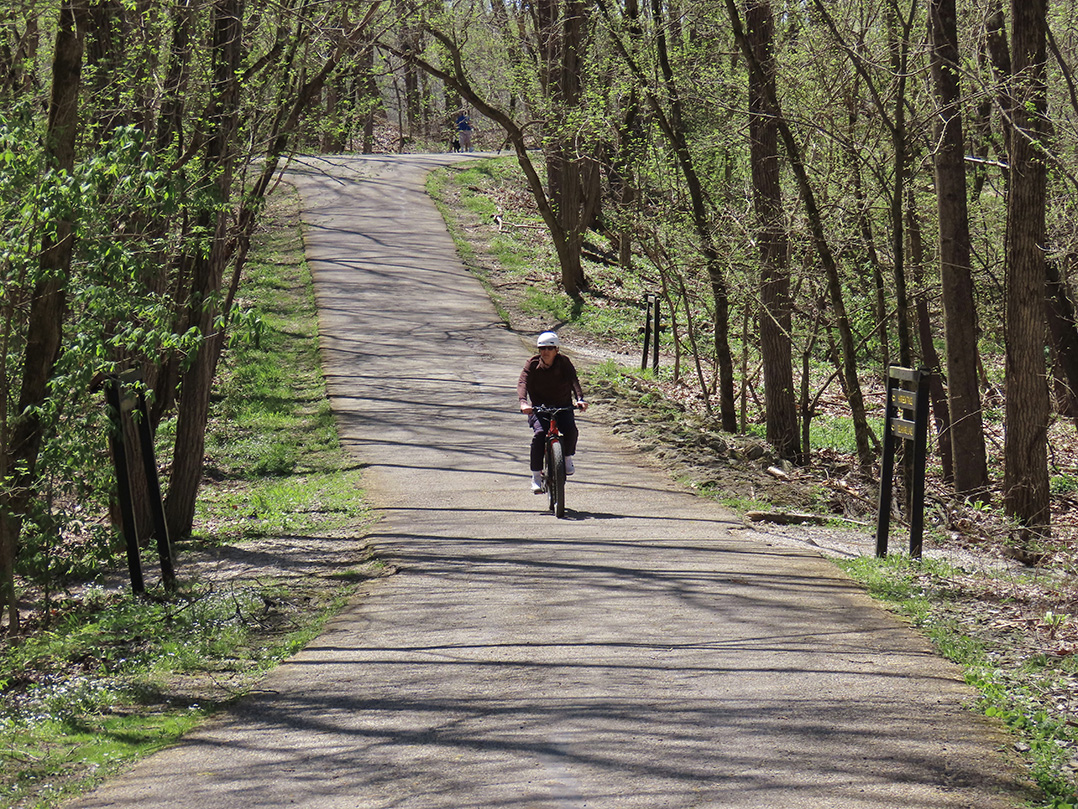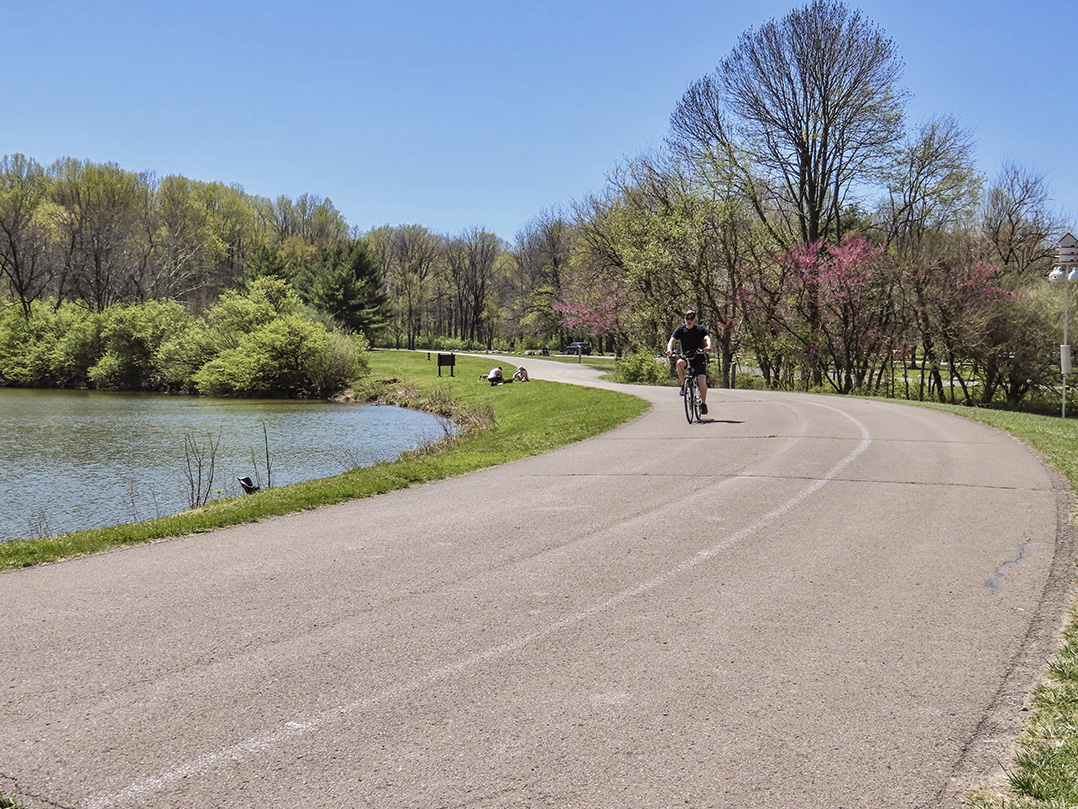If he could instantly be transported to a mountain biking destination, Fishers resident Paul Arlinghaus said he would go to North Carolina or Moab, Utah.
But he doesn’t have to travel far to ride trails.
Arlinghaus is about an hour away by bike, or 20 minutes by car, from Fort Harrison State Park, 6000 N. Post Rd. in Lawrence The park, which opened in 1996 after Fort Harrison was deactivated by the U.S. Army, has offered wooded bike trails — a short beginners loop and two longer trails totaling just more than 7 miles — for about a decade.
Although not as scenic as the most popular mountain-biking destinations in the U.S., and not as lengthy and challenging as the trails at Brown County State Park, the Fort Harrison State Park trails are the bread and butter of Arlinghaus’ training for mountain bike racing. The 53-year-old mechanical engineer and member of the Hoosier Mountain Bike Association, said he rides the park’s trails about 20 times a year.
“That most important trail is always that local trail,” Arlinghaus said. Popular vacation destination trails are nice, “but those trails aren’t as important as using local trails,” he added. “That’s the trail I’m going to ride throughout the year to keep my skills.”
The Fort Harrison State Park trails — the beginners’ 1.5-mile loop; the 4.2-mile Lawrence Creek Trail, rated as intermediate; and the 3-mile Schoen Creek Trail, rated as expert — have proven popular, especially on weekends and weekday evenings.
Ride at midday during the week, “and you might have the trail to yourself,” Arlinghaus said. But other times the multi-use trails can get crowded, and riders must be aware not only of each other but hikers, who have the right-of-way.
“It’s really up to the user to make good decisions about when to use the trails, depending on what you want,” said Arlinghaus, who utilizes the trails more to brush up on the technical aspects of his riding since going full speed can be dangerous with hikers.
Part of the trails’ appeal is the suburban setting, said Indiana Department of Natural Resources interpretive naturalist Emilie Sweet, who has worked at Fort Harrison State Park since August 2022. Cyclists can pedal through wooded areas with moderately rugged terrain, observe the scenery and still hear traffic on nearby 56th Street, Fall Creek Road and Interstate 465.
“I think it’s probably the urban setting we’re in,” Sweet said. “(The park) is a really nice getaway.”
Although she has worked at the park less than a year, Sweet said the trails seem to be appreciated by cyclists she has talked to.
“Every time I have been on the trails leading hikes or what have you, people are on them biking,” Sweet said.
Fort Harrison State Park has the potential to be even more popular as a trail-riding destination, said Mike Hufhand, who lives on the northeast side and is an avid mountain biker and advocate for mountain bike infrastructure.
Hufhand designed the Fort Harrison State Park bike trails and was part of the volunteer crew that did most of the work constructing them, he said. He rides at the park about once a month but said the experience feels “bittersweet” because “I know what it could be, and we’re not even close.”
The Lawrence Creek and Schoen Creek trails can be combined for a 7.2-mile loop, but that’s not much compared to the nearly 30 miles of trails in Brown County State Park. Much of the Fort Harrison property has been designated as nature preserves, confining the park’s trails to a limited area.
More room to ride is especially important for those who are trying mountain biking for the first time, Hufhand said. He’d also like to see what he called “first-class connectivity,” giving riders safe routes separated from vehicular traffic so they can pedal to the park to enjoy the trails.
“It’s a great park. It has awesome potential,” Hufhand said. “It could be one of the best urban parks in America.”
Cyclists on state park trails must purchase an Off-Road Cycling permit. Cost is $5 per cyclist per visit, or $20 for an annual permit. The permit is not required for the beginners’ loop at Fort Harrison State Park. The cycling permit is separate from park admission.

Tackle a trail at Fort Harrison State Park
You don’t have to drive far to reconnect with nature if you live on the northside.
Fort Harrison State Park, 6000 N. Post Rd, offers 14 miles of trails for hikers, ranging from easy to difficult and featuring a variety of terrain, flora and scenery – all in a setting not far removed from the hustle and bustle of Indianapolis.
“We do have things to see while hiking with us,” said Emilie Sweet, an Indiana Department of Natural Resources interpretive naturalist who leads group hikes at the park.
Each of Fort Harrison State Park’s six trails has distinctive features:
- Lawrence Creek Trail, at 4.2 miles, the park’s longest trail and rated difficult, winds through upland woods and ravines. Parts of it remain wet all summer, making for heavy wildflower growth. Lawrence Creek Trail is shared by hikers and bikers. It is, according to users of AllTrails.com, the best place to hike in the park.
- Schoen Creek Trail, another rated as difficult, is 3 miles and also is shared with bicycle riders. A mowed trail cuts through wetland and prairie grasses. Schoen Creek Trail, according to Sweet, has many twists and turns.
- Fall Creek Trail, 1 mile, and Camp Creek Trail, 2 miles, are rated as moderate. Fall Creek Trail follows lowlands along Fall Creek before heading uphill as it nears Duck Pond. It features manmade wooden steps and observation decks. Fall Creek Trail is, according to the DNR, good for birding, fishing access, and wildflower and tree identification. Camp Creek Trail passes an old army rubble pile and includes scenic vistas from the bluffs of Camp Creek valley.
- For easier hikes, Harrison Trace Trail is 3.2 miles of asphalt-surface trail for walkers, cyclists and joggers. The easiest route to Duck Pond, it is hilly, and much of it is tree-covered. The Tree ID Trail is 1 mile of mowed grass that features signs that help hikers identify trees along the route.
“We do have a decent little mix of trails,” said Indiana Department of Natural Resources interpretive naturalist Emilie Sweet, who has worked at Fort Harrison State Park since August 2022.
Fall Creek, Camp Creek and Harrison Trace are the most heavily traveled, especially on weekends, Sweet said. Hikers seeking solitude should visit on weekdays. Those who want a more social experience can take part in a group hike. Schedules are available in flyers at the park; on the park’s website, in.gov/dnr/state-parks/parks-lakes/fort-harrison-state-park; and on social media, including the park’s Facebook page.





